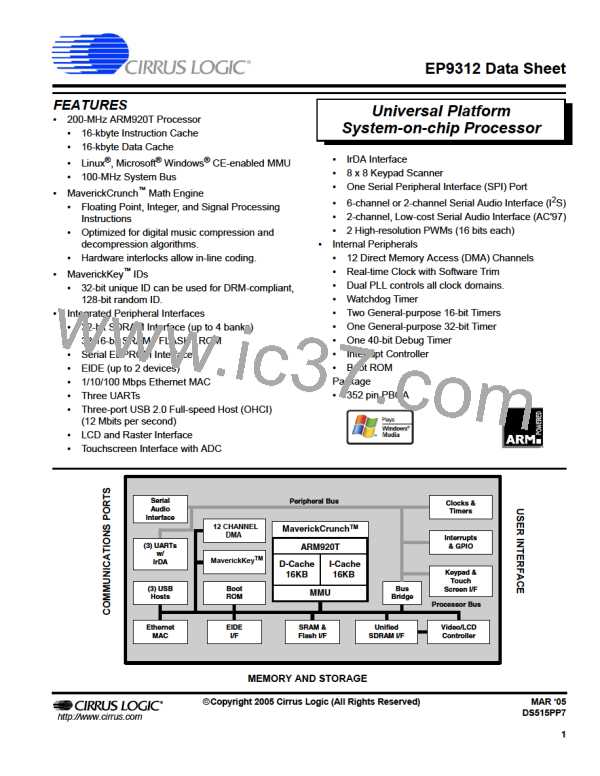EP9312
Universal Platform SOC Processor
provide OEMs with a method of utilizing specific
hardware IDs such as those assigned for SDMI (Secure
Digital Music Initiative) or any other authentication
mechanism.
Processor Core - ARM920T
The ARM920T is a Harvard architecture processor with
separate 16-kbyte instruction and data caches with an 8-
word line length but a unified memory. The processor
utilizes a five-stage pipeline consisting of fetch, decode,
execute, memory, and write stages. Key features include:
Both a specific 32-bit ID as well as a 128-bit random ID
are programmed into the EP9312 through the use of
laser probing technology. These IDs can then be used to
match secure copyrighted content with the ID of the
target device the EP9312 is powering, and then deliver
the copyrighted information over a secure connection. In
addition, secure transactions can benefit by also
matching device IDs to server IDs. MaverickKey IDs
provide a level of hardware security required for today’s
Internet appliances.
•
•
ARM (32-bit) and Thumb (16-bit compressed)
Instruction Sets
32-bit Advanced Microcontroller Bus Architecture
(AMBA)
•
•
16-kbyte Instruction Cache with lockdown
16-kbyte Data Cache (programmable write-through or
write-back) with Lockdown
®
®
®
•
•
•
•
MMU for Linux , Microsoft Windows CE, and other
operating systems
General Purpose Memory Interface (SDRAM,
SRAM, ROM, FLASH)
Translation Look Aside Buffers with 64 Data and 64
Instruction Entries
The EP9312 features a unified memory address model
where all memory devices are accessed over a common
address/data bus. A separate internal port is dedicated to
the read-only Raster/LCD refresh engine, while the rest
of the memory accesses are performed via the Processor
bus. The SRAM memory controller supports 8, 16 and
32-bit devices and accommodates an internal boot ROM
concurrently with 32-bit SDRAM memory.
Programmable Page Sizes of 1 Mbyte, 64 kbyte,
4 kbyte, and 1 kbyte
Independent lockdown of TLB Entries
™
MaverickCrunch Math Engine
The MaverickCrunch Engine is
a
mixed-mode
coprocessor designed primarily to accelerate the math
processing required to rapidly encode digital audio
formats. It accelerates single- and double-precision
integer and floating point operations plus an integer
•
•
1 to 4 banks of 32-bit, 66- or 100-MHz SDRAM
One internal port dedicated to the Raster/LCD
Refresh Engine (Read Only)
multiply-accumulate
(MAC)
instruction
that
is
•
•
Address and data bus shared between SDRAM,
SRAM, ROM, and FLASH memory
considerably faster than the ARM920T's native MAC
instruction. The ARM920T coprocessor interface is
utilized thereby sharing its memory interface and
instruction stream. Hardware forwarding and interlock
allows the ARM to handle looping and addressing while
MaverickCrunch handles computation. Features include:
NOR FLASH memory supported
Table B. General Purpose Memory Interface Pin Assignments
Pin Mnemonic
Pin Description
SDCLK
SDRAM Clock
•
•
•
•
•
•
•
•
IEEE-754 single and double-precision floating point
32 / 64-bit integer
SDCLKEN
SDCSn[3:0]
RASn
SDRAM Clock Enable
SDRAM Chip Selects 3-0
SDRAM RAS
Add / multiply / compare
Integer MAC 32-bit input with 72-bit accumulate
Integer Shifts
CASn
SDRAM CAS
SDWEn
SDRAM Write Enable
Chip Selects 7, 6, 3, 2, 1, 0
Address Bus 25-0
Floating point to/from integer conversion
Sixteen 64-bit register files
CSn[7:6] and CSn[3:0]
AD[25:0]
DA[31:0]
DQMn[3:0]
WRn
Four 72-bit accumulators
Data Bus 31-0
™
MaverickKey Unique ID
SDRAM Output Enables / Data Masks
SRAM Write Strobe
SRAM Read / OE Strobe
SRAM Wait Input
MaverickKey unique hardware programmed IDs are a
solution to the growing concern over secure web content
and commerce. With Internet security playing an
important role in the delivery of digital media such as
books or music, traditional software methods are quickly
becoming unreliable. The MaverickKey unique IDs
RDn
WAITn
6
©Copyright 2005 Cirrus Logic (All Rights Reserved)
DS515PP7

 CIRRUS [ CIRRUS LOGIC ]
CIRRUS [ CIRRUS LOGIC ]